In 1973, farmers in Heshui County, Gansu Province discovered a piece of white ivory while digging in the sand. After 35 days of excavation by the excavation team, all the fossils were finally exposed: it was the skeleton of an elephant, inserted diagonally in the sand, with its feet stepping on stones.
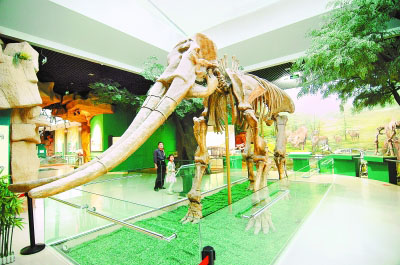
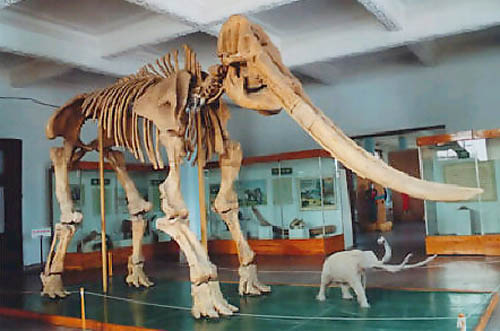
A replica of the Yellow River elephant fossil on display at the Gansu Provincial Museum
This fossil was named "Yellow River Elephant". It is 4 meters tall and 8 meters long. Its ivory is more than 3 meters long, like two long swords, so it is also called saber-toothed elephant. The skeleton of the Yellow River elephant is the most complete skeleton of a saber-toothed elephant found in the world.
It is speculated that 3 million years ago, the Gansu region was full of rivers and lakes. One day, a saber-toothed elephant slipped and fell into the mud while drinking water by the river. It was buried in the sand, and its skeleton was completely preserved. After geological evolution, this area was raised into a plateau, and the Yellow River elephant was able to see the light of day again.
The Yellow River Elephant fossil is very famous in China. There is a text called "Yellow River Elephant" in Chinese primary school Chinese textbooks. The fossils of the Yellow River Elephant are currently on display in the Paleontology Hall of the Beijing Museum of Nature.
Nearly passed by a fossil
In Qingyang City, Gansu Province, the Malian River, known as the Mother River, is the largest river in Qingyang. It was called Huangjian in ancient times, Nishui in the Han Dynasty, and Maling River after the Northern Wei Dynasty. In the Tang Dynasty, because the two major tributaries Maling River and Baima River merged in the south of Qingcheng, the river section below Qingcheng was called the Malian River.
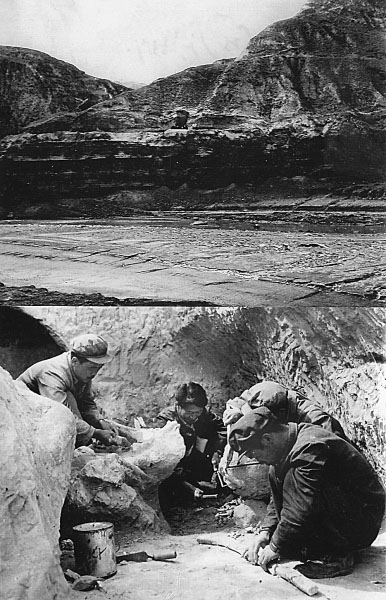
The picture above shows the excavated landform, and the picture below shows the excavation site.
The Malian River passes through Hejiapan Township and Banqiao Township in Heshui County.
At the end of 1972, Heshui County planned to build the Huokou Hydropower Station on the Mu Banner production team on the bank of the Malian River in Banqiao Commune. The water from the Malian River would be used to irrigate thousands of acres of nearby land and increase grain production. This is very good news for the arid yellow land.
Jiang Dengpan, then director of the Heshui County Grain Bureau, was a veteran revolutionary who joined the Shaanxi-Gansu-Ningxia guerrillas in 1938. He was appointed by the county party committee and the county government to serve as the commander-in-chief of the project. At that time, there were neither modern excavators nor modern bulldozers, and all work was done manually. Many local farmers actively participated in this project, carrying their own hoe and shovel, carrying baskets, pushing frame trucks and other agricultural tools.
On January 20, 1973, as usual, the construction site was busy with traffic and people coming and going. At about two o'clock in the afternoon, on the hillside to the west of the river bank, the crowd suddenly scrambled and grabbed something. Some people shouted that the "keel" had been dug out, and at the same time someone ran towards the village holding the "keel". Jiang Dengpan, who was working with the masses at the time, immediately rushed over following the sound and quickly stopped the looting masses. He walked to the "keel" and picked up a piece of something that was thick like stone and bone at the mouth of the bowl. It looked very smooth and very hard. He found that the broken section was still in the sand. Why was it so long? (It was later discovered through excavation that what Jiang Dengpan saw at that time was the ivory that was first unearthed. After sorting and restoring, the ivory was 3.04 meters long.) What is buried under the loess? Jiang Dengpan didn't know, but he decided decisively with the sense of responsibility of an old revolutionary: This must be a treasure and should be turned over to the state. No one is allowed to dig up or disturb it.
Jiang Dengpan asked the production captain who came after hearing the news to lead people to recover the "keel" that had been snatched away by the crowd, and assigned two militiamen to take a section of the "keel" and rush to the county seat 15 kilometers away to report to the county cultural center. Jiang Dengpan People were organized on the beach to plant signs with dead trees and form a circle.
Early the next morning, Xu Junchen from the County Cultural Center rushed to the construction site to inspect it and thought it was an unknown paleontological fossil. He rushed back to the county seat that day and reported to the county leaders. County leaders asked Jiang Dengpan to strengthen on-site protection, completely recover the "keels" that the migrant workers had taken home, and at the same time telegraph the provincial cultural authorities. Subsequently, the county sent police to protect the scene. However, news of the "keel bone" spread like wildfire, and more and more people dug it secretly. A small section of the elephant's two incisors was still secretly dug out.
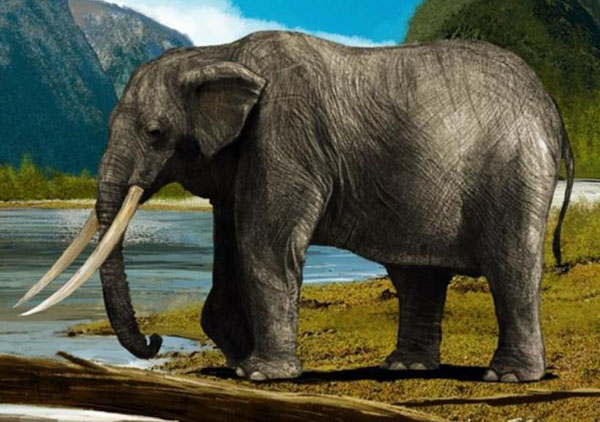
A mysterious and difficult excavation
Twenty days had passed, and it was not until March 10 that the province sent Xie Junyi from the Provincial Museum and invited Gu Zugang, a teacher from the Department of Geology and Geography of Lanzhou University, to Heshui County to form a three-person joint survey team with Xu Junchen.
On March 18th and 19th, the survey team went to the site to conduct surveys. They tried digging one meter inward from the exposed section of the elephant's incisor, and found that after the incisor extended 50 centimeters inwards, it connected with the maxillary bone. It is estimated that there is a well-preserved elephant body. Unfortunately, most of the exposed incisors have been lost, but fortunately, the traces of the left incisor buried in the ground are still well preserved, providing scientific basis for subsequent restorations.
The news of the exploration of the Yellow River elephant fossils quickly reached the petroleum geology department that was conducting geological exploration work in Heshui, and technical personnel from the Changqing Oilfield Battle Command also went to the site for inspection. And again telegraphed the news to the Institute of Vertebrate Paleontology and Paleoanthropology, Chinese Academy of Sciences.
On March 21, the survey team received a telegram from the China Institute of Vertebrate Paleontology and Paleoanthropology saying: "Receiving a report from the Changqing Oilfield Headquarters, a large number of fossils have been found in the Heshui area. Please protect the site. Our institute will send people there."
This telegram made the members of the survey team very embarrassed. I wonder if they should continue to follow up? Or quit? After discussion, Xie Junyi finally drafted a telegram to the Institute of Vertebrate Paleontology, Chinese Academy of Sciences. After arriving in Xifeng Town, Xie Junyi reported to the person in charge of the Cultural Group of the Political Department of the Provincial Revolutionary Committee by phone, and then issued the message in the name of the Cultural Group of the Political Department.
The telegram stated that the fossils found in Heshui were Elephants-Are-Endangered.html">elephants and not reptiles. Xie Junyi will wait to meet the guests from the Chinese Academy of Sciences at the Qingyang District Guesthouse in Xifeng Town.
On the evening of April 1, Zhao Jufa, a technical worker from the Chinese Academy of Sciences, arrived in Xifeng Town. Zhao Jufa said: "After receiving the telegram, I learned that it was an elephant, not a reptile. The other four scientific researchers who were planning to come did not come. I was asked to help the province unearth the fossils alone."
A problem arises. Xie Junyi still doesn’t know the province’s attitude. Should he dig or not? Fossils or not? How to pay for it? It will cost at least five to six hundred yuan. In desperation, Xie Junyi and Zhao Jufa had to go to Heshui County first. On the morning of April 4, Xie Junyi had a phone call with Lanzhou and once again reported the situation to the Cultural Section of the Political Department of the Provincial Revolutionary Committee. At the same time, he requested to send five to six hundred yuan for excavation expenses and living food stamps.
After purchasing some simple supplies in Heshui County, they entered the construction site. On April 5, a four-member excavation team composed of Zhao Jufa from the Institute of Vertebrate Paleontology and Paleoanthropology of the Chinese Academy of Sciences, Xie Junyi from the Provincial Museum, Han Tianbao and Xu Junchen from the Qingyang Regional Cultural Center visited the Heshui County party and government leaders and the Huokou Hydropower Station construction site. With strong support, formal excavation began.
At that time, it was the most beautiful season of the year along the Malian River. On the hillsides on both sides, there were patches of apricot groves covered with green apricots; on the flat Sichuan platform, green wheat seedlings undulated with the wind; the crystal clear The Malian River flows to the southeast, and teal ducks swim across the river from time to time... However, the excavation team members who were inspired by this huge discovery did not bother to appreciate the beautiful mountains and rivers here.
The excavation work followed the natural environment and adopted the method of large-scale uncovering, that is, using the exposed elephant fossil as the base point, extending 2 meters to both sides and 4 meters inward according to the hillside terrain, and excavating from top to bottom. On April 9, the elephant skull was exposed. As the excavation work progressed, the elephant's spine, leg bones, ribs, shoulder blades, pelvic bones, wrist bones, etc. were unearthed one after another, proving that it was indeed a well-preserved elephant body buried in situ.
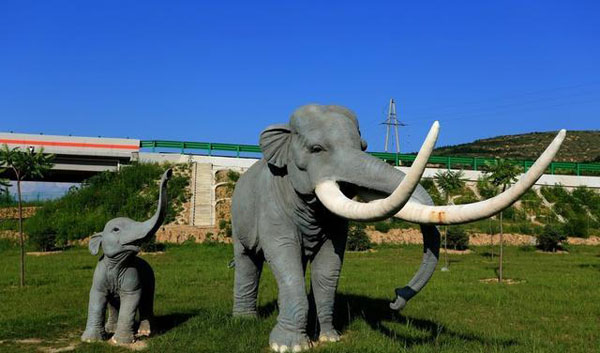
Everyone was very happy, and Zhao Jufa was even more excited. He said that their research institute did not have such a complete elephant fossil! It should be number one in the country.
Digging out an elephant's head is an unprecedented challenge for them. The elephant's brain has a honeycomb structure. Once dug, the head may break into pieces. They decided to use the boxing method to excavate the whole. First, I estimated the size of the elephant head, then made a wooden box without a bottom cover, cut grooves around the elephant head, put it into the wooden box, poured plaster, shoveled it flat and sealed the top cover. The wooden box was slowly pushed down, the bottom was turned up, and plaster was poured into it to reinforce and seal the bottom cover. In this way, the elephant head becomes a whole and will not be broken.
Buried fossils are very loose when they are first unearthed and will be damaged if you are not careful, so the excavation work is very meticulous and arduous. The excavated fossils must be infiltrated and reinforced with chemicals while drying, otherwise they will weather and scatter naturally. After a series of careful treatments, we began to collect the left scapula on April 16. The upper part was removed, and the underlying bone was dug out.
The excavation started on April 5 and ended on May 17. Except for rainy days, the excavation lasted 35 days.
During the excavation, a telegram came from the Institute of Ancient Ridges of the Chinese Academy of Sciences saying that the fossils would be shipped to Beijing for observation and study first, and then sent back to Gansu if needed. Wang Yi, who is in charge of cultural relics work at the Gansu Provincial Revolutionary Committee, decided that the fossils should be transported to Beijing first and the issue of ownership should not be discussed. As for where to put it, it should be done according to the central government’s opinion. It should be placed wherever the central government thinks.
Packed and transported in a lively and festive atmosphere
How can there be Elephants-Are-Endangered.html">elephants in the arid Loess Plateau? The surrounding people regarded this discovery as an anecdote and traveled hundreds of miles to come in groups to visit. During the more than 40 days of excavation, more than 20,000 people came to visit. At the peak, there were more than 1,000 people a day, and the passenger shuttle bus from Xifeng to Heshui was extended to the construction site. The county canteen is operating under a tent at the construction site, and there are countless food and beverage vendors along the road, which is more lively than visiting a temple fair.
On the one hand, there was lively celebration among the masses, and on the other hand, the excavation work was progressing in an orderly manner. After sorting, the excavated bones of various parts of the elephant were packed into 12 large boxes. In order to ensure the absolute integrity of various skulls, they used thick wooden boards to fix the surroundings on the spot, sealed them with plaster, and covered the top and bottom to make them very solid and secure.
But the unavoidable question came again. How to transport the huge and heavy elephant head from the mountain path to the highway? (It was later weighed at Xi'an Railway Station that I found out that the box weighed 3,000 kilograms.) At first, 19 people used ropes to pull it, but it failed to work. Later, it was increased to 42 people to pull it, but it still did not pull. Then a 3-ton coach was used to pull it. In one day, it only moved 5 meters. The excavation site is 500 meters away from the road. The only wayOnly simple roads can be built and tractors can be used to pull them out.
Heshui County quickly mobilized hundreds of people, and starting from May 20, it took only three days to build a 3-meter-wide road. The "Dongfanghong" crawler tractor from the county tractor station drove to the excavation site, and the huge elephant skull was finally pulled to the side of the simple road.
Transportation became a problem again. There were very few cars at that time, and most of them were small cars of three or four tons. Where could I find a big car? Zhao Jufa called people from Changqing Oilfield and asked them to dispatch vehicles to help. Changqing Oilfield dispatched two vehicles, one with a load of ten tons and the other with a load of 6 tons. Another crane came. Unexpectedly, the crane broke down halfway.
They were worried again, so they had no choice but to continue to use the earth method. They first dug a soil trench, drove the car into it, and then invited a Dongfanghong tractor to push the car. This process lasted for several days, and it was not until the 28th that everyone was loaded into the car and rushed to Heshui County overnight. It left Heshui County on the 29th and was delivered to the freight yard of Xi'an West Railway Station for train on the 30th. From then on, the Yellow River elephant was gone forever.
After the Yellow River elephant fossils arrived in Beijing, the Institute of Vertebrate Paleontology and Paleoanthropology of the Chinese Academy of Sciences invested more than 30 people in repairing, restoring and mounting them. After being mounted, the ancient elephant is 4 meters tall, 8 meters long, and has incisors 3.03 meters long. The individual is large, the age is early, and the preservation is good. It is the only discovery in the world so far. Because the ancient elephant fossils were unearthed in the Yellow River Basin, it was named Yellow River Elephant.
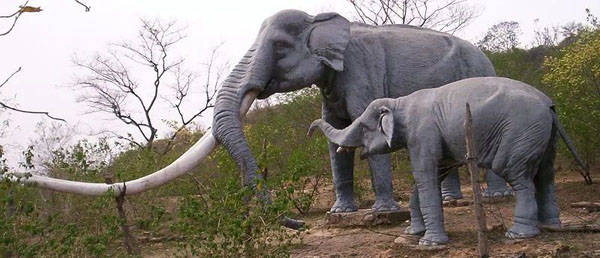
In October 1974, the Yellow River Elephant was exhibited at the Beijing Museum of Natural History. Except for the tail vertebrae, this tall Yellow River elephant fossil skeleton is entirely mounted on fossil bones. The front end is an ivory that is more than 3 meters long, followed by the skull and mandible, and even the hyoid bone, which is difficult to find, is preserved. Among the more than 100 toe bones, not even the three to four centimeters long terminal phalanx has been lost. The complete preservation of the Yellow River elephant fossil skeleton is very rare in the history of elephant fossil discovery. The discovery of the Yellow River elephant fossil not only provides reliable data for paleontological research, but also provides a rare scientific basis for studying the ecological environment before and after the formation of the Qingyang Loess Plateau in Gansu Province. Now standing in front of the tall skeleton of the Yellow River elephant fossil, one seems to see an elephant striding towards people carrying a gorgeous picture of the sea turning into mulberry fields.
After the Yellow River elephant fossils were exhibited in Beijing, they caused a sensation all over the world. Later, as a friendly envoy of the Chinese people, it traveled across the ocean and was exhibited in Japan and Singapore, where it was warmly welcomed. Shanghai, Tianjin, Lanzhou and other cities have also replicated and exhibited Yellow River elephant fossils. Currently, tall Yellow River Elephants-Are-Endangered.html">elephants can be found in ancient elephant museums in Henan, Chongqing and other places. Through these museums and the beautiful short article "Yellow River Elephant" in primary school textbooks, the Yellow River Elephant has entered the memory of one generation after another. However, in the past 42 years, the farmers who participated in the excavation of Yellow River elephant skeleton fossils have never had the opportunity to see the tall body of the elephant they unearthed with their own hands. This can not but be said to be a pity. Fortunately, not long ago, original replicas of Yellow River elephant skeleton fossils were also made available in Qingyang City and Heshui County, Gansu Province. People in Qingyang can also see the tall and majestic appearance of the Yellow River Elephant in its hometown.
animal tags: elephant fossil stegodon museum
We created this article in conjunction with AI technology, then made sure it was fact-checked and edited by a Animals Top editor.